
Amy Ruth Tan is an American author known for the novel The Joy Luck Club, which was adapted into a film of the same name in 1993 by director Wayne Wang.
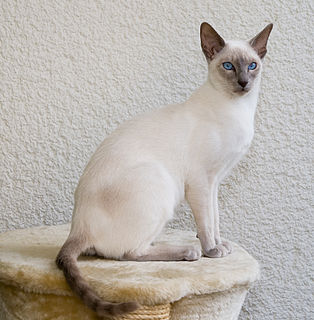
The Siamese cat is one of the first distinctly recognized breeds of Asian cat. Derived from the Wichianmat landrace, one of several varieties of cat native to Thailand, the original Siamese became one of the most popular breeds in Europe and North America in the 19th century. The carefully refined, more extreme-featured, modern-style Siamese is characterized by blue almond-shaped eyes; a triangular head shape; large ears; an elongated, slender, and muscular body; and various forms of point colouration. Other than colouration, the modern-style Siamese bears little resemblance to the original stock, and the more moderate, traditional, or "old-style" Siamese, with a much rounder head and body, has been re-established by multiple registries as the Thai cat. The International Cat Association describes the modern Siamese as affectionate, social, intelligent, and playful into adulthood, often enjoying a game of fetch. Siamese tend to seek human interaction and also like companionship from other cats.

Sagwa, the Chinese Siamese Cat, or simply Sagwa, is a Canadian-American children's animated television series based on the children's book of the same name by Amy Tan which aired on PBS Kids, produced by Canada-based animation studio CinéGroupe and Sesame Workshop.
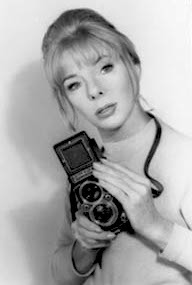
Dare Wright was a Canadian–American children's author, model, and photographer. She is best known for her 1957 children's book, The Lonely Doll.
Oliver Grainger is a Canadian former child voice actor.

The Egg Tree is a 1950 book by Katherine Milhous that won the 1951 Caldecott Medal. It is based on the author's family tradition and tells the classic tale of a Pennsylvania Dutch Easter, with its main characters being Katy and Carl. One day, near Easter, they look for Easter eggs and found eggs that their grandmother had painted on a tree. They are interested, so they ask their grandmother about the eggs. They eventually create one, and it becomes a big success the next Easter.

Catwings is a series of four American children's picture books written by Ursula K. Le Guin, illustrated by S. D. Schindler, and originally published by Scholastic from 1988 to 1999. It follows the adventures of kittens who were born with wings. Catwings is also the title of the first book in the series. The series is in print from Scholastic as of August 2015.

The Hundred Secret Senses is a bestselling 1995 novel by Chinese-American writer Amy Tan. It was published by Putnam, and was shortlisted for the 1996 Orange Prize for Fiction. While the story is fictional, it is based on the experiences of Tan and on stories told by her mother.
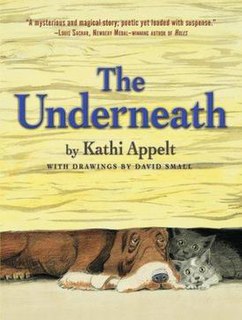
The Underneath is a children's book by Kathi Appelt. It tells the story of an abandoned cat who goes to live with a maltreated hound dog underneath a crooked old house in a bayou on the border between Louisiana and Texas. Published in 2008, The Underneath is a John Newbery Honor book, ALA Notable Children's Book and a National Book Award Finalist.

The Opposite of Fate: A Book of Musings is a 2003 memoir by Amy Tan. It is a collection of essays about her life, family, and influences.
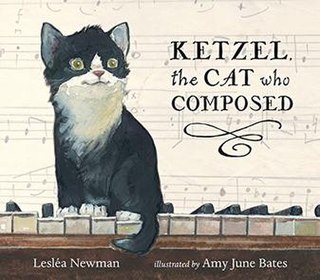
Ketzel, the Cat who Composed is a children's picture book by Lesléa Newman. Based on a true story, it is about the friendship between Moshe Cotel and a kitten, Ketzel, who composes a musical piece that Cotel enters into a music competition and receives a special mention.
Mouse, Look Out! is a 1998 children's picture book by Judy Waite and Norma Burgin. It is about a mouse being stalked by a cat.

The Dog Who Had Kittens is a 1991 children's picture book by Polly Robertus and illustrated by Janet Stevens. It is about a basset hound who finds himself adopting some kittens.

The Boy Who Climbed Into the Moon is a 2010 children's novel by David Almond. It is about a boy, Paul, who wants to touch the sky; he then climbs a ladder to the Moon and goes inside.
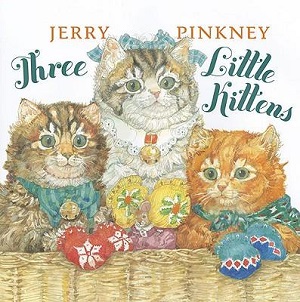
Three Little Kittens is a 2010 children's picture book of the classic nursery rhyme adapted by Jerry Pinkney.

Albidaro and the Mischievous Dream is a 2000 book by Julius Lester and illustrator Jerry Pinkney telling why teddy bears look as if they have a secret.

Wee Winnie Witch's Skinny: An Original Scare Tale is a 2004 picture book by Virginia Hamilton and illustrated by Barry Moser. It is about a witch, Wee Winnie, who terrifies Uncle Big Anthony but is then killed by Mamma Granny.

The Boy & the Bindi is a 2016 children's picture book by Vivek Shraya and illustrated by Rajni Perera. It is about a young boy's obsession with his mother's bindi and his experiences when he wears one.

Big Cat, Little Cat is a 2017 children's picture book written by Elisha Cooper. It was published by Roaring Brook Press, a subsidiary of Macmillan Books. In the story, a large, white cat welcomes a new black cat into a family. The white cat then dies, and the cycle begins anew when the family adopts a new kitten. Cooper was inspired to write the story after his family experienced a similar situation. Critics praised his illustrations, for their ability to help further the story's messages and themes. These monochromatic illustrations were different than the style Cooper normally employed when illustrating a book. The book was well-reviewed, and received a 2018 Caldecott Honor.

















